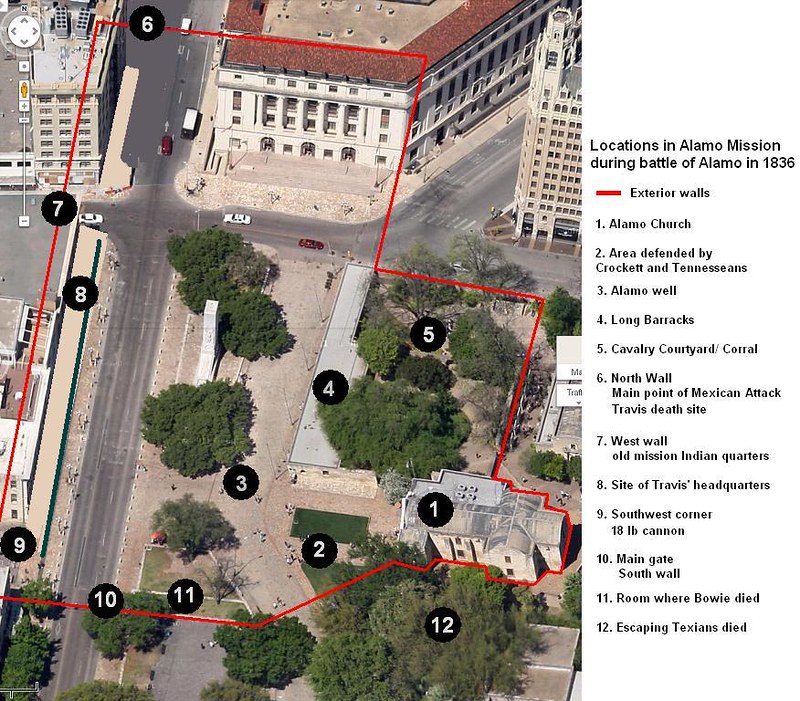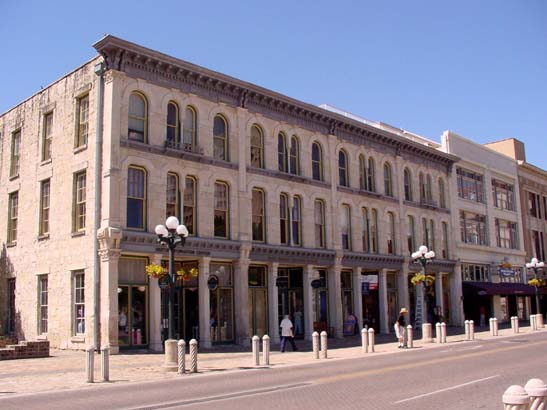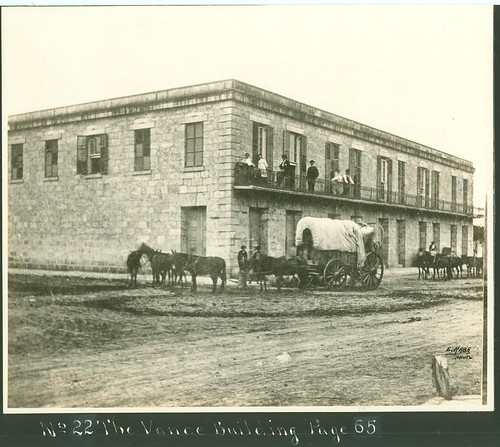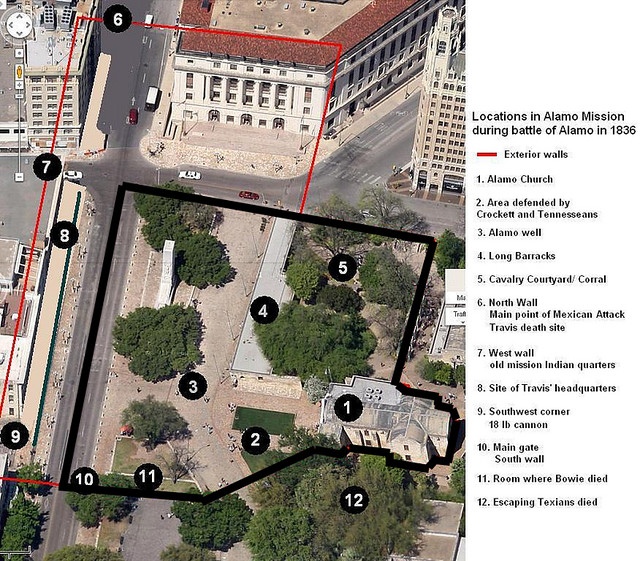That would make sense.
Alamo maps
10,800 Views |
47 Replies |
Last: 10 yr ago by p_bubel
William DeRyee
Daughters of the Republic of Texas Collections
quote:
As the medium is not firmly identified, so the photographer remains even less certain. For some time the name of William DeRyee has been associated with these prints. DeRyee was a chemist, among other professions and trades, born in Bavaria in 1825, the family name Düry, and an immigrant to America in the late 1840's. In 1856, after travels, inventions, and prospecting, and on his way to mines in Arizona, DeRyee came to Texas and stopped in San Antonio. Here he began working as a chemist and, in connection with that, as a photographer. In 1859 he had a studio in the French Building, completed the preceding year at the southeast corner of Main Plaza and the subject of one of the photographs given by Mrs. Tylor. At various times in his career, DeRyee was associated with the artists Carl G. von Iwonski, Hermann Lungkwitz, and William C. A. Thielepape. The latter was also a musician and a post-Civil War mayor of San Antonio, whose home was on the grounds of the Alamo and pictured in a well-known Hermann Lungkwitz drawing, painting, and lithograph of Crockett Street.
Daughters of the Republic of Texas Collections
Excellent thread.
There's a relevant opinion piece in the SA Express News today:
http://www.mysanantonio.com/opinion/commentary/article/Lack-of-vision-has-stunted-the-Alamo-as-a-4428043.php
What do we think of this proposal to "reclaim" the original footprint of the Alamo? Does anyone know anything about the Alamo Plaza Restoration Project?
http://www.alamoplazaproject.com/index.html
There's a relevant opinion piece in the SA Express News today:
http://www.mysanantonio.com/opinion/commentary/article/Lack-of-vision-has-stunted-the-Alamo-as-a-4428043.php
What do we think of this proposal to "reclaim" the original footprint of the Alamo? Does anyone know anything about the Alamo Plaza Restoration Project?
http://www.alamoplazaproject.com/index.html
I would love for it to happen, but here is why it can't and won't come to fruition:

The building, the old post office, are now Federal Offices and they just finished completely renovating the building. Before that, a couple of years back they were talking about making it an Alamo Museum. Which would have made sense, so that never happened.
The building to the left of the old post office is now hotel Indigo (6), and they just spent a ton of money renovating the structure so they could move in.
(7) is Houston St, a busy thoroughfare that the city has spent a considerable amount of time and money promoting for development... and having some success. I doubt you can dead-end that street without some serious negative impact.
(8)(9) is now just a carnival like atmosphere and what has prompted most of this push to reclaim the plaza. Its private property and expensive real estate. (8) is the old woolworth building ( and old site of the Sam Maverick home) and while only built in the 50s it is a decent building that's about 4 storys. That could probably be demolished without too much outcry. The Crockett building next to it though, is a gem, and it would be hard to stomach tearing it down. Its solid limestone so moving it would be a huge task, though possible.

(9) the Ripley's believe it or not structure no one would have problems with it being gone... other than the tenant and owner.
You could possibly fudge the north wall to follow Houston St and possible split Alamo St but I don't know if people would accept that.
The plaza has always been "neglected" a bit, but it's not quite fair to a lot of people that got involved with purchasing and repairing the property when the army vacated. It is a tough situation, in the middle of the heart of the city with little planing for the area when most of the plaza was developed. Its always been a case of reclaiming more and more of the site over the past 150 years from private interests.

The building, the old post office, are now Federal Offices and they just finished completely renovating the building. Before that, a couple of years back they were talking about making it an Alamo Museum. Which would have made sense, so that never happened.
The building to the left of the old post office is now hotel Indigo (6), and they just spent a ton of money renovating the structure so they could move in.
(7) is Houston St, a busy thoroughfare that the city has spent a considerable amount of time and money promoting for development... and having some success. I doubt you can dead-end that street without some serious negative impact.
(8)(9) is now just a carnival like atmosphere and what has prompted most of this push to reclaim the plaza. Its private property and expensive real estate. (8) is the old woolworth building ( and old site of the Sam Maverick home) and while only built in the 50s it is a decent building that's about 4 storys. That could probably be demolished without too much outcry. The Crockett building next to it though, is a gem, and it would be hard to stomach tearing it down. Its solid limestone so moving it would be a huge task, though possible.

(9) the Ripley's believe it or not structure no one would have problems with it being gone... other than the tenant and owner.
You could possibly fudge the north wall to follow Houston St and possible split Alamo St but I don't know if people would accept that.
The plaza has always been "neglected" a bit, but it's not quite fair to a lot of people that got involved with purchasing and repairing the property when the army vacated. It is a tough situation, in the middle of the heart of the city with little planing for the area when most of the plaza was developed. Its always been a case of reclaiming more and more of the site over the past 150 years from private interests.
Awesome thread!
This thread is awesome! Would any of you have a good book recommendation that covers the struggle at the Alamo? I realize to get a full understanding it may require multiple books but is there one really good one that covers the before during and after of the battle?
A Time to Stand is an older but generally reliable account.
I took a bunch of photos around Main Square yesterday but I'm slammed with work right now. I should have something posted in the next couple of days.
I'm still looking for the location of the surrender photo and ran across these newspaper clips from the Alamo Express in the 1860s and thought I would share it here.
Pretty interesting reading.
Pretty interesting reading.
I really don't think at this point I'm going to find the info I'm looking for online. That photo could really be from any part of the city as they marched from his home, the Alamo and Main Plaza.
I'll keep an eye out though.
[This message has been edited by p_bubel (edited 4/30/2013 1:05a).]
I'll keep an eye out though.
[This message has been edited by p_bubel (edited 4/30/2013 1:05a).]
{Bring a thread back from the dead}
Speaking of keeping an "eye out," I think I might have a better fix for the image posted on page one of the surrender with the Paint Shop sign:
The would make the two story property the Vance Hotel (wrongly called house) and if it is the Vance Hotel I know the location. Houston St and St Mary's. Now the Guenther Hotel.
I'll have to look around a little bit more and get the orientation of the building correct but I believe that original photo could be a great before and after shot for me.
Speaking of keeping an "eye out," I think I might have a better fix for the image posted on page one of the surrender with the Paint Shop sign:
quote:
In a 2-story stone building, afterwards a hotel, Vance House. Established as administrative offices for U.S. army during the Mexican War, 1846-1847. At this site on Feb. 16, 1861, Gen. David E. Twiggs surrendered $1,600,000 in Federal property to forces of Confederate Texas. For a year headquarters for Texas Military Affairs, which were later administered from Houston, Bonham and Shreveport. Site is part of complex of San Antonio military tradition that extends from early Spanish day, to the Alamo, to 20th century.
The would make the two story property the Vance Hotel (wrongly called house) and if it is the Vance Hotel I know the location. Houston St and St Mary's. Now the Guenther Hotel.
I'll have to look around a little bit more and get the orientation of the building correct but I believe that original photo could be a great before and after shot for me.

 [/url][url=https://flic.kr/p/n5wYeK]Vance Hotel (1872) by Paul Bubel, on Flickr
[/url][url=https://flic.kr/p/n5wYeK]Vance Hotel (1872) by Paul Bubel, on FlickrThe Vance Hotel - Opened in 1872
quote:
In 1851, the Vance brothers purchased the Frontier Hotel for $500 and replaced the hotel with a two-story building that the Army could lease to house troops stationed in San Antonio. The facility continued to serve as a military headquarters until 1872 when the building was returned to the Vances.
View image at large size:
[url]http://mysapl.files.wordpress.com/2011/11/vance_house.jpg[/url]
I hate the Flickr formatting.
[This message has been edited by p_bubel (edited 4/13/2014 7:16p).]
Additionally, the loss of the actually Vance House was a completely ****ing travesty.


quote:
The Vance House, a Greek Revival mansion, was built between 1857 and 1859 by James Vance, a local banker. Col. Robert E. Lee, walking under the grape arbors on its grounds, was said to have decided to resign a colonelcy in the United States (Union) Army and join the Confederacy, though he was fundamentally opposed to rebellion. Having made up his mind, he announced at a dinner in the Vance House’s great dining room: “If Virginia secedes, I shall stand with her.” Virginia seceded and Lee became the Commander of the Confederate armies. The Federal Reserve Bank currently stands on the site.
Featured Stories
See All
21:35
12h ago
4.2k
Buzz Williams' Ags are proving why experience, continuity still matter
by Luke Evangelist
13:15
14h ago
2.7k

